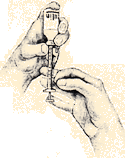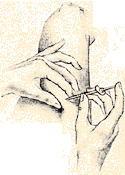| 1. Pharmacological Therapy: |
Type 1 Diabetes
Insulin is the mainstay therapy for patients with type 1 disease. Most patients are on human insulins, which are synthesized by recombinant DNA technology. Beef (no longer available in the U.S.) and pork insulins are less preferred due to potential of antigenic (allergic) reactions such as itching and skin reactions at the injection sites. Of the available insulins, some are rapid acting, or short acting, which are used mainly before each meal. Others are intermediate acting, or long acting, which are injected once or twice daily under the skin. Table 1 is a summary of the onsets of action, duration of action and other characteristics of the various insulins available (in the United States).
Click here to see the Table 1
Type 2 Diabetes
Of the proposed pathology of type 2 diabetes (see figure 1), there are now different oral pharmacological agents to target the specific defects: there are three categories of agents, the insulin secretagogues, inhibitors of glucose breakdown, and the insulin sensitizers. The insulin secretagogues include sulfonylureas and metiglinides, which are used to stimulate more insulin secretion. Alpha-glucosidase inhibitors delay the absorption of glucose and are usually used to control post-meal hyperglycemia. The insulin sensitizers include biguanides and thiazolidinediones, which can help the available insulin to be taken up more effectively. Table 2 lists the different agents with their sites and mechanisms of actions.
Click here to see the Table 2 Pharmacologic Classes to Control Hyperglycemia in Type 2 Diabetes
The selection of agents for a patient with type 2 disease will depend on the degree of hyperglycemia, particular defects, as well as other contraindications that may be present. Table 3 lists the agents according to their relative potency, other non-glycemic effects and adverse effects.
Click here to see the Table 3 Relative Efficacy and Adverse Effects of the Oral Agents Used in Type 2 Diabetes
If we look at the patient according to the natural progression of diabetes, oral agents can also be picked according to the severity of disease. (See table 2) For example, an alpha glucosidase inhibitor or metiglinide may be most appropriate for someone who has mildly elevated glucose level after eating a meal. As this patient becomes less controlled with higher glucose and elevated fasting levels, we may then consider sulfonylureas, biguanides, or thiazolidinediones, all of which are considered more potent agents. There will be patients who may have multiple defects in the pathogenesis of their disease, therefore, will require a combination of agents (with different mechanisms of action) in order to control their diabetes. This can include the combination of different oral agents as well as combination of oral agents and insulins. Metformin can be particularly useful among patients who have concurrent problems with weight, cholesterol and triglycerides because it can also improve these indices. Concerns with the use of these oral agents lie in the side effects they can cause. Therefore, frequent and regular monitoring of patients is necessary to avoid hypoglycemia while they are on sulfonylureas, and to avoid stomach gas and diarrhea while they are on metformin. Metformin is also associated with a rare problem of lactic acidosis when it's accumulated in the body with deterioration of kidney function. Gastrointestinal gas and diarrhea are often causes of therapy discontinuation in patients taking acarbose and miglitol. The thiazolidinediones are also associated with rare liver toxicities and need frequent monitoring of the liver enzymes.
It's recommended that the first stage of therapy for diabetes should include diet and exercise. An average size adult patient with diabetes should receive approximately 2000 calories per day with 60% carbohydrate, 20% protein, and 20% fat. However, calories or fat should be more restricted if the patient is overweight or has abnormal cholesterol / triglycerides; carbohydrate limited if glucose is uncontrolled; and protein also restricted if the patient has kidney complications from diabetes. Exercise should be incorporated into the therapeutic program (with doctor's approval and supervision) because it will enhance the body's sensitivity to insulin and increase utilization of glucose. Diet and exercise should be encouraged in all patients with diabetes and should remain a component of the therapeutic program as long as patients are compliant and gain benefits. Unfortunately, there are many patients who are not willing to diet or physically unable to exercise, and therefore should receive medications to aggressively control glucose early on during their disease.
Type 1 Diabetes
In a patient with newly diagnosed type 1diabetes, clinicians often start with a simple schedule of insulins. To improve glucose control, doses of the insulin(s) and / or the schedule may have to be adjusted often and on an as-needed basis. A typical regimen to start with includes intermediate- or long-acting insulin once or twice daily with short- or rapid-acting insulin before meals. However, patients with type 1 disease often have big fluctuations of glucose levels and suffer from extreme hyperglycemia or hypoglycemia. Therefore, tighter control is often necessary. Until recently, changing the timing of insulin injections and the dosage of different insulins were all that could be done to maximize glycemic control in type 1 patients. Over the last two years, however, rapid acting insulins have been made available, which made the control of glucose more precise. (See table 1) Instead of injecting the short-acting regular insulin about 30 minutes before meals, patients can inject the new rapid-acting insulins (lispro, aspart) within 15 minutes before meals. In addition, the newly available basal insulin glargine will make the control of glucose more consistent due to its slow release profile, which acts similarly to the physiological pattern of insulin release in our body.
 Before injecting insulin, tap the syringe to rid it of any air bubbles. Before injecting insulin, tap the syringe to rid it of any air bubbles. |
 Prick the skin and underlying fatty tissue to avoid injecting into an artery or vein. Prick the skin and underlying fatty tissue to avoid injecting into an artery or vein. |
Type 2 Diabetes
Due to the recent differentiation in the pathogenesis of type 2 diabetes, there have been changes in the way we manage the disease. As previously mentioned, type 1 patients have an absolute lack of insulin and require insulin injections; type 2 patients have a relative lack of insulin, either due to insensitivity to insulin or an insulin receptor defect, improper timing of insulin secretion, abnormal glucose production, or a combination of these factors. In patients with type 2 diabetes, herapeutic approaches should target the specific defect(s) in each patient. A proposed algorithm based on the level of glycemic control is described as following:
| Nutritional therapy / Exercise program x 3 month trial |
 If inadequate response or therapeutic goal is not met.... If inadequate response or therapeutic goal is not met.... |
| |
| Add oral monotherapy x 4-12 weeks, titrate to maximum tolerable dose |
 If inadequate response or therapeutic goal is not met.... If inadequate response or therapeutic goal is not met.... |
| |
| Add second oral agent x 4-12 weeks, titrate to maximum tolerable dose |
 If inadequate response or therapeutic goal is not met.... If inadequate response or therapeutic goal is not met.... |
| |
Add Oral agent(s) + insulin
OR Insulin therapy alone
OR Oral agent(s) day + insulin at bedtime |
|